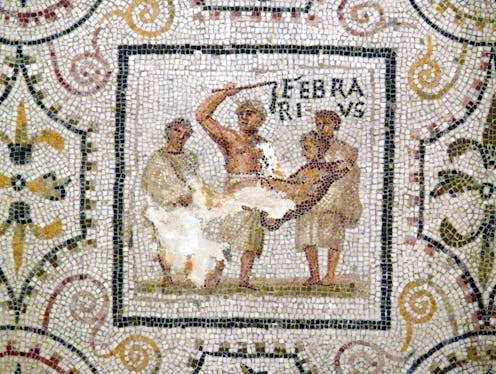
Why does February has the least number of days? Why does it not have 30 or 31 days like the rest of the eleven months? – Simi, aged 15, Mauritius
The reason February is shorter than other months comes down to the history of how we measure and divide the year.
We know that the Earth takes 365 days and just under six hours to go around the Sun. The division of those days into twelve months is a human invention to measure time. But it hasn’t always been divided that way.
In the first surviving ancient Roman calendar, there were ten months. The calendar was shaped by the agricultural year, so began in spring with March and ended 304 days later in December. There was no work to be done in the fields during the two months of winter, and the rest of days in the year were simply not counted in the calendar.

Curious Kids is a series by The Conversation that gives children the chance to have their questions about the world answered by experts. If you have a question you’d like an expert to answer, send it to curiouskids@theconversation.com and make sure you include the asker’s first name, age and town or city. We won’t be able to answer every question, but we’ll do our very best.
In 731BC Numa Pompilius, the second king of Rome, decided to line the calendar up with the phases of the moon. There are 12 cycles of the moon each year, so the calendar was divided into twelve months. January and February were added and the new calendar year lasted 355 days.
The Romans believed that even numbers were unlucky, so the length of the months in Pompilius’ calendar alternated between 29 or 31 days. However, the length of the calendar year meant that the final month – February – was left with only 28.
In Rome, February was linked with rituals of purification, or februum – giving it its name. During the festival of Lupercalia purification ceremonies took place to prepare buildings and people for the feasts and sacrifices of the festival. During the festival of Feralia food and gifts were brought to cemeteries, to honour the dead and keep them happy so they would not rise and haunt the living.
However, a calendar year lasting 355 days created its own problems. Because the Earth takes longer than this to go round the Sun, as years went by the months and the seasons started to fall out of alignment. So an extra month called Mercedonius was added to the calendar before the start of March.
Mercedonius was not used every year. It was added whenever it was necessary to re-align the months and the seasons. It had either 27 or 28 days, creating a year that lasted for either 377 or 378 days.
But this had unfortunate consequences for February. Mercedonius started on 24th February, cutting four days from a month that was already the shortest in the calendar. And although Mercedonius helped to link the months with the seasons, its use was unpredictable. People living far from Rome might not realise that the extra month had been added to the calendar.
Another calendar
Another new calendar tried to fix this problem. In the Julian Calendar, named after Julius Caesar and dating from 45 BCE, a year lasted 365 days.
None of the extra ten days were added to February. There were twelve months, each of which were the same length as in our calendar. To keep the calendar accurate, an extra day was added to February once every four years – a leap year.

However, an extra day each four years is actually a bit too much to correct the difference between a 365-day year and the 365 and just under a quarter days in which the Earth orbits the Sun. By the middle of the sixteenth century, the Julian calendar was out of alignment with the seasons and cycles of the year by ten days.
This led to the creation of another calendar. The Gregorian Calendar was introduced in 1582, named after Pope Gregory XIII, and is still in use today. In the Gregorian calendar, no century year can be a leap year unless it is exactly divisible by 400 - so 2000 was a leap year, with an extra day in February, but not 1900. This prevents the problems caused by the Julian calendar.
This sounds simple enough, but that ten-day error in the Julian calendar still needed to be corrected. In 1582, ten days were taken out of the calendar in countries that adopted the Gregorian calendar. This meant that the day after 4 October was 15 October - and the dates in between never existed.
Helen Parish does not work for, consult, own shares in or receive funding from any company or organisation that would benefit from this article, and has disclosed no relevant affiliations beyond their academic appointment.
This article was originally published on The Conversation. Read the original article.







